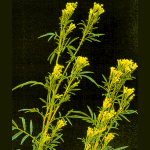| Common Name: |
Stinking Roger |
| Other Names: |
Muster-John-Henry, Khaki Weed |
| Botanical Name: |
Tagetes minuta |
| Genus: |
Tagetes |
| Family: |
Asteraceae |
| Native Location: |
C and S America; widely naturalized |
| Cultivation: |
Well-drained, fertile soil in sun. Deadhead plants to prolong flowering. Botrytis and foot rot may affect plants. Tagetes minuta and, to a lesser extent, T. patula, are widely used in companion planting; the former has an irritant sap that may cause dermatitis; the latter is often used to repel soil nematodes, slugs, and whitefly from tomatoes, though cultivars vari in effectiveness. |
| Propagation: |
By seed sown in spring, at 21°C (70°F) |
| Harvest: |
Plants are cut when flowering and distilled for oil, or dried for infusions. Tagetes lucida and T. minuta are used in ointments for external use. Leaves (T. lucida, T. patula) and flowers (T. patula) are picked in summer for use either fresh or dried in infusions. |
| Height: |
30cm-1m (1-3ft) |
| Width: |
10-75cm (4-30in) |
| Hardiness: |
Frost hardy to half hardy |
| Parts Used: |
Whole Plant, oil. |
| Properties: |
A strongly aromatic, diuretic, purgative herb that relaxes spasms, improves digestion, destroys intestinal parasites, and is effective against many pathogenic organisms. It is an effective insecticide. |
| Medicinal Uses: |
Internally for gastritis, indigestion, and intestinal worms. Externally for hemorrhoids and skin infections. |
| Culinary Uses: |
Dried leaves give an apple-like aroma to soups, meat dishes, and vegetables. |
| Economic Uses: |
Plants are grown to protect crops against nematodes and slugs, and to suppress perennial weeds, such as Aegopodium podagraria (See, Goutweed), Calystegia sepium (Bindweed), and Elymus repens (See, Quack Grass). Dried plants are hung indoors or added to bedding to deter insects (Africa). Oil is used in perfumery, commercial food flavoring and tobacco. |
| Bibliography: |
Encyclopedia of Herbs by Deni Brown Copyright © 1995, 2001 Dorling Kindersley Limited. pp 379-380 |

